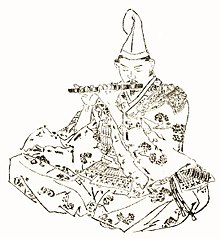Nitta (clan)
The Nitta ( Japanese 新 田氏 ) were a family of the Japanese sword nobility ( Buke ), which was derived from Minamoto no Yoshishige (源 義 重; 1135–1202), a son of Minamoto no Yoshikuni (源 義 国; 1082–1155), who again a son of Minamoto no Yoshiie (源 義 家; 1039–1106) was. The ancestors belong to the Seiwa Genji .
Genealogy (selection)
- Yoshishige (義 重; † 1203), the eldest son of Yoshikuni, was named "Nitta Tarō". When Minamoto no Yoshitomo started war against the Taira in 1180 , Yoshishige joined him and moved with him to Kamakura . In 1611, the Tokugawa , who were his descendants, posthumously awarded him the title of Chinjufu-Shogun.
In addition to the Tokugawa, the Yamana , Satomi and later the Ōdate also descend from Yoshishige .
- Yoshisuke (義 助), Yoshisada's brother, founded the Wakiya clan .
- Yoshiaki (義 顯; † 1337), the eldest son of Yoshisada, fought in all of his father's battles. When he was besieged in Kanasaki Castle ( Echizen Province ) and retreated to Somayama Castle (杣 山城), Yoshiaki stayed there to stop the enemy. When he saw that he could not hold the castle, he committed suicide in 1337. Prince Takanaga died with him.
- Yoshioki (義興; † 1358), the second son of Yoshisada, supported Kitabatake Akiie in the siege of Kamakura and took the city with him in 1337. The position of Akiie, who was killed the following year, was taken by his brother Akinobu . Yoshioki fortified Otoko (igte 山城) castle together with Akinobu, but was driven out of it and sought protection in Yoshino. In 1352 he was able to expel Ashikaga Motouji (足 利基 氏; 1340–1367) from Kamakura , together with his brother Yoshimune and his cousin Yoshiharu , and gain a foothold there. He, in turn, was then expelled from the city by Ashikaga Takauji and sought refuge in Echigo Province , from where he was able to take possession of the Kōzuke and Musashi provinces again. He was captured by Takezawa Nagahiro, and Hatakeyama Kunikiyo , Minister under Motouji, sentenced him to death. He was drowned on the Rokugō River at Yaguchi no Watari (矢 口 渡) (Musashino). There he is venerated under the name "Nitta Daimyōjin" (新 田 大 明 神).
- Yoshimune (義 宗; 1332-1368), third son of Yoshisada, was chosen after the death of his older brother to take over the domains of his father. He fought Ashikaga Yoshiakira on Mount Yoshino and then defeated Takauji at Kanai-ga-hara (Musashi). Then he fortified - together with Prince Munenaga - the Fuefuki Pass (笛 吹 峠), but was defeated there in 1352 by Takauji, whereupon he sought protection in Echigo. He conquered half of the province and built a castle there. Yoshimune died during an argument with Uesugi Norimasa.
- Sadakata (貞 方; † 1410), Yoshimune's son, continued the fight for the south courtyard, even after the latter had given up his rights to the north courtyard. In 1395 he was beaten and fled to Mutsu Province . The following year he defeated the Yūki and the Ashina and settled at Shirakawa Castle. In his last attempt to attack Kamakura, he was captured and beheaded on Shichi-ri-ga-hama (七里 ガ 浜; Sagami Province ).
After the Meiji Restoration in 1868, a descendant of the family was given the title of baron.
Remarks
- ↑ Chinjufu-Shōgun (鎮守 府 将軍) was the title of a military governor in the peripheral provinces of Japan.
- ↑ a b During this time the imperial court was divided into a north and a south court (see Namboku-chō ).
literature
- Edmond Papinot: Nitta, 新 田 . In: Historical and Geographical Dictionary of Japan. Reprint of the 1910 edition. Tuttle, 1972, ISBN 0-8048-0996-8 .
